Reprinted from the February 1999 Sailing World, with permission from Sailing World, and Zack Leonard. Not to be further reprinted without permission from Zack Leonard. Photos not to be used without further permission from Onne van der Wal.
| On the Wire of the Fabled Five-0 |
| By Zack Leonard |
Photos by Onne Van Der Wal |
 THERE'S NO TIME-SPACE
HALLUCINATION, NO MIND-melting blur. The hyperbolic speed imagery on the TV,
the sudden camera cuts, the frenetic music � none of these devices can capture the
essence of the 505. Unlike the hair-raising International 14 and the hyperkinetic 49er,
the 505's speed is smooth and hydraulically dampened; accelerations and decelerations are
stable and linear, not violent and highly loaded. The boat has a feeling of perfectly
balanced, highly civilized control and power � just like a full-speed roller-coaster ride
on Nyquil.
THERE'S NO TIME-SPACE
HALLUCINATION, NO MIND-melting blur. The hyperbolic speed imagery on the TV,
the sudden camera cuts, the frenetic music � none of these devices can capture the
essence of the 505. Unlike the hair-raising International 14 and the hyperkinetic 49er,
the 505's speed is smooth and hydraulically dampened; accelerations and decelerations are
stable and linear, not violent and highly loaded. The boat has a feeling of perfectly
balanced, highly civilized control and power � just like a full-speed roller-coaster ride
on Nyquil.
In the family tree of rapid transit, the 505 is a second cousin to the silky Jaguar V-12 of the '60s, a brother to the legendary Hawaiian longboard, and the prime progenitor of the modern, high-performance monohull. But unlike a flesh-and-blood patriarch, the Five-0 hasn't faded with time and is enjoying an American resurgence.
Last September the International 505 class held its World Championship at the Hyannis YC on Cape Cod. The gathering felt more like a good old-fashioned Bible-thumping, stump-preaching revival than a high-performance dinghy regatta. Drawn by the promise of long, windy races on the wire of this planing dinghy, 212 pilgrims came to Massachusetts from 10 nations on four continents, hauling 106 boats, hundreds of pieces of wet gear, parts and tools, and a shared addiction to sailing faster this time.
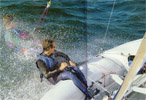 Two weeks of racing, which included the
North American Championship as a warm-up, culminated in the coronation of Nick Trotman and
Mike Mills as world champions. The first Americans to win the event in 16 years, Trotman
and Mills are leading a youth movement that has top sailors from college sailing, Olympic
classes, and the Vanguard 15 class all satisfying their performance jones in the 505
class. The result in the U.S. has been almost 50-percent growth of the 505 class over the
past five years.
Two weeks of racing, which included the
North American Championship as a warm-up, culminated in the coronation of Nick Trotman and
Mike Mills as world champions. The first Americans to win the event in 16 years, Trotman
and Mills are leading a youth movement that has top sailors from college sailing, Olympic
classes, and the Vanguard 15 class all satisfying their performance jones in the 505
class. The result in the U.S. has been almost 50-percent growth of the 505 class over the
past five years.
The class allows talented sailors who don't mind tinkering with their boats the chance to race at a high level � a level just short of the take-no-prisoners, saw-your-leg-off Olympic level. Such refugees from Lasers and 470s as Mike Zani, Tim Collins and Nick Adamson have flocked to the 505, done well, and had a great time while still holding (gasp!) jobs.
 Amateur participation doesn't mean the racing is second rate. Among
non-Olympic classes the 50 fleet is at the top of the heap. The roster of 505 sailors and
alums is second only in distinction to the Laser, and includes heavy-hitters Paul
Elvstrom, Gary Knapp, Cam Lewis, Ethan Bixby, Steve Benjamin, Jonathan and Charlie McKee,
Carl and Carol Buchan, and a host of others whose names you wouldn't know because they
come from other countries � but take it from me, they're good, really good.
Amateur participation doesn't mean the racing is second rate. Among
non-Olympic classes the 50 fleet is at the top of the heap. The roster of 505 sailors and
alums is second only in distinction to the Laser, and includes heavy-hitters Paul
Elvstrom, Gary Knapp, Cam Lewis, Ethan Bixby, Steve Benjamin, Jonathan and Charlie McKee,
Carl and Carol Buchan, and a host of others whose names you wouldn't know because they
come from other countries � but take it from me, they're good, really good.
The 505 is a physical boat. Plenty of horsepower (35% more than a 470) and a gigantic spinnaker require top physical conditioning and an intuitive skill at dealing with extra power. The rigs are flexible, and the adjustable rake, shroud tension and mast ram allow the sails to be depowered easily during a race � but the sails are just so damned big that you still need to be fairly beefy to tame the beast. The ideal combined crew weight is somewhere between 340 and 380 pounds, but the boat definitely prefers a big, strong crew. In no way does the helmsman get to skate: the back end requires a lot of strength to work that main all the way upwind (the class still uses 16-mile racecourses at the worlds), so you don't see too many tykish 470-style drivers. Women have been successful in the class, as have small male skippers, but they better be tough. Sally Lindsay, Alison Jolly and Carol Buchan have whipped the boys more than once, even so, the class is mostly male. (Only six women competed at the '98 Worlds.)
![]() The 505 is as modern today as it was when it
was first conceived in 1954. With flexible class rules that allow for progress in sail,
rig and foil design but blackball revolutionary advances like major hull shape changes
that can quickly make boats obsolete, the class is what I would call a
"limited-development class." You can fool with masts, sails, blade shapes (sizes
and profiles) rigging ideas, in fact almost everything except the hull shape.
The 505 is as modern today as it was when it
was first conceived in 1954. With flexible class rules that allow for progress in sail,
rig and foil design but blackball revolutionary advances like major hull shape changes
that can quickly make boats obsolete, the class is what I would call a
"limited-development class." You can fool with masts, sails, blade shapes (sizes
and profiles) rigging ideas, in fact almost everything except the hull shape.
The Five-0 class has steadfastly refused to throw its hat into the Olympic ring, fearing an arms race that would drive out regulars who have made this among the strongest one-designs in the world. The rules allow for hulls to be constructed of epoxy, foam, or honeycomb core and even Kevlar, which gives the boats a much longer shelf-life than most similar dinghies. The pre-preg, vacuum-bagged hulls can last a very long time. Ask Zani and Peter Alarie, who finished fourth at the Worlds in a 19-year-old Lindsay hull. Class veteran and Worlds organizer Tom Kivney explains that Mark Lindsay's 505s almost killed the class when he first introduced them. Other boats were relatively expensive in the late '70s and made all existing boats obsolete. At the time, class organizers were probably cursing Mark for driving new-boat prices out of the reach of young, first-time buyers and for rendering used boats uncompetitive. But as other builders began to build boats of similar quality, and the first Lindsays went up for sale, the class reaped the benefits. Used boats are competitive: A young hot-shot can spend $5,000 for an old Lindsay or Waterat and put the heat on the best in the world.
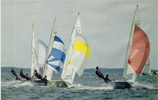 Like all truly great sailboat designs, the
505 is so well conceived that it's extremely easy to push through the water. About 20
years ago a group of hard-sailing young Americans figured out how to get a Five-0 ripping
with a Proctor D mast section, and things haven't changed much since. So, in this
limited-development class, what are the latest and greatest improvements?
Like all truly great sailboat designs, the
505 is so well conceived that it's extremely easy to push through the water. About 20
years ago a group of hard-sailing young Americans figured out how to get a Five-0 ripping
with a Proctor D mast section, and things haven't changed much since. So, in this
limited-development class, what are the latest and greatest improvements?
The only striking advance in the way the boats are sailed has been the advent of exaggerated rake adjustments as the breeze builds, allowing the sailors to twist open, and depower more effectively than ever. The Proctor D section still dominates the class, and sail design is surprisingly similar among two or three competitive builders who outfit almost the entire class. Trotman and Mills and the other top Americans sailed with an Ullman inventory developed by Jay Glaser and Howard Hamlin, while the top English teams sailed with Pinnell & Bax sails that looked virtually identical. These shapes represent years of subtle refinement from the shapes that won 20 years ago for Lewis, Knapp, Taylor and Bixby.
Same hulls, same masts, similar sails � so where's all the development? At dinner on the first night of the pre-worlds, I found myself in the company of royalty. The conversation pit was studded with the flamboyantly confident Cam Lewis and his steady and staid partner, Ethan Bixby, with counterpoint from grown-up California beachboy Howard Hamlin and his crew, Mike Martin, who recently emigrated to the West Coast from eastern climes. The conversation turned to new developments and future breakthroughs. While Lewis and Bixby were using the same boat that they had sailed to a world championship almost 20 years ago and took the conservative approach to change, Hamlin and Martin proved to be California dreamers, looking for that little extra to push them over the top. Hamlin recalled a conversation he'd had a year earlier with Krister Bergstrom, four-time world champion from Sweden. The businesslike Swede had mused that all the recent refinements and effort seemed to be in the sail department, while nearly everyone sailed with the stock boards that the factory shipped with the boats.
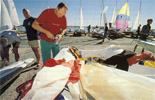 The lightbulb that went on at that point
led to a one-year board-development program that involved three different shape changes.
The class rules allow any centerboard that fits in the trunk: it can jibe or stay fixed,
it can be short and wide, it can be tall and thin, but not many people have experimented
much with this variable. Later I learned that Tyler Moore and Macy Nelson had been
experimenting with boards, too. Hamlin and Martin rode their new blades to second place,
but didn't have a concrete judgement on their benefits.
The lightbulb that went on at that point
led to a one-year board-development program that involved three different shape changes.
The class rules allow any centerboard that fits in the trunk: it can jibe or stay fixed,
it can be short and wide, it can be tall and thin, but not many people have experimented
much with this variable. Later I learned that Tyler Moore and Macy Nelson had been
experimenting with boards, too. Hamlin and Martin rode their new blades to second place,
but didn't have a concrete judgement on their benefits.
One Australian team created a novel drum-based system that allowed them to cant the mast to windward like a windsurfer rig. The system seemed to work relatively well and they showed speed upwind in breeze at times, but the speed gain was inconsistent. Another advance embraced by much of the fleet was the use of Mylar laminates in the sails. Ullman sailmaker Jay Glaser explained that the Mylar sails must be cut a little differently from the Dacron sails to account for the different stretch characteristics of the cloth. He seems to have worked his way through the problem: Glaser's Mylar sails were first and third while his Dacron sails were fourth.
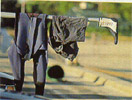 With all the room for innovation and the
outward differences in appearance, one is still struck by the similarity of the boats.
Alarie postulates that the boats have developed toward a median that is fast in all wind
conditions. Radical departures from the existing standards can be fast in different
conditions, but the world championship is conducted over seven days, and almost always
provides a variety of wind and sea conditions over that period. Hence the focus in
development is on consistent performance over a range of conditions.
With all the room for innovation and the
outward differences in appearance, one is still struck by the similarity of the boats.
Alarie postulates that the boats have developed toward a median that is fast in all wind
conditions. Radical departures from the existing standards can be fast in different
conditions, but the world championship is conducted over seven days, and almost always
provides a variety of wind and sea conditions over that period. Hence the focus in
development is on consistent performance over a range of conditions.
This year's World Championship was a gunfight between several excellent British and American teams. Skippers Trotman and Mark Upton-Brown jumped out to an early lead with Ian Barker and Hamlin close behind, while Zani and Pinnell plugged along consistently until the end. The final results highlighted the strength of the class in these two countries, but failed to show the normal prowess of 505 teams from France, Denmark, and Germany. The Brits were surprised to find that their traditional advantage in breeze had been usurped by the speedy, athletic American teams. The result was a tug of war determined more by tactics, starting, and the ability to recover from tough windward mark roundings than by pure speed. Trotman and Mills, with their tall straight backs and stoic approach to the event, were especially adept at extricating themselves from tricky spots, regularly recovering from poor first beats to score solid finishes and flash their confident, devlish grins at the finish-boat spectators.
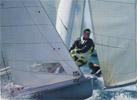 The secret to wading forward through the
fleet (as it always seems to be in 505s) was top-notch spinnaker handling and three-sail
reaching technique. The class rules specify equilateral triangles, which make the reaches
tighter than a standard race course. In any breeze it's a struggle to fetch the mark with
the spinnaker. Technique and guile (knowing when to hoist and when to jib-reach high until
you can lay with a clear lane) can amount to major gains on these hairy courses.
The secret to wading forward through the
fleet (as it always seems to be in 505s) was top-notch spinnaker handling and three-sail
reaching technique. The class rules specify equilateral triangles, which make the reaches
tighter than a standard race course. In any breeze it's a struggle to fetch the mark with
the spinnaker. Technique and guile (knowing when to hoist and when to jib-reach high until
you can lay with a clear lane) can amount to major gains on these hairy courses.
The windward mark in the middle of the pack is like a beehive, and the bear who gets away with the honey is the one who best manages a complex set of variables. The reaches are long, and it's crucial to sail in clear air the entire time. If one boat rolls over the top and collapses your chute, it can lead to a long, funereal procession of boats cruising by while you try to get back in the high lane where you can breath again.
The 505 also has a sweet spot, the angle at which it reaches fastest: the sails are trimmed properly, the crew is all the way out, the board is set at the optimal position and the boat is flat. Things get tricky when the reach is 2 miles long and the wind is shifting. Should you continue sailing the sweet angle when you aren't quite fetching the mark? Are you a bit headed now? If you can get lifted a little later, maybe you can lay the mark without ever deviating from this fast, sweet angle....
Complicate that question by adding other boats, and realize that by sailing the sweet spot you may have to sail below the course of other boats around you who hold high, on or above the layline. If you choose to hold high, you depower by pulling the board up (reducing lift) and easing vang and mainsheet, but you go a little slower. The risk-reward equation can produce big gains and losses.
It's worth remembering that these people are trying to make rational, tactical decisions with 20 boats close by, all going 15 knots and all freeking out that they are about to flip. At these speeds any small jitter on the helm can cause a nuclear accident. The boats skip over the waves making sharp smacking sounds as they hit the crests, while the grins on the sailor's faces give rise to Texas rodeo-style whoops. It's pretty hard to beat.
 The 505 has attracted a loyal group of
die-hard sailors who have made long-term commitments to the class, firm in the belief that
there could never be a logical reason to move on and sail any other type of boat.
Naturally, a class so fraught with perilous speed is rife with war stories. In the company
of veterans like Kivney and Barry Kuehl one hears the glorious yarns of yesteryear
recounted with the gleaming eyes if the perpetually youthful. Kivney recounts the famous
race at the '78 Worlds when the breeze piped up above 30 and only a small part of the
fleet remained upright. Then the Giant Puff hit and flipped every boat in the fleet except
Kivney, who felt something funny happening as the rig on his Five-0 loaded up so hard that
the mainsheet bridle, which was anchored to the seat tank, pulled the whole tank right off
the floor of the boat and left them sinking slowly with the lone upright mast.
The 505 has attracted a loyal group of
die-hard sailors who have made long-term commitments to the class, firm in the belief that
there could never be a logical reason to move on and sail any other type of boat.
Naturally, a class so fraught with perilous speed is rife with war stories. In the company
of veterans like Kivney and Barry Kuehl one hears the glorious yarns of yesteryear
recounted with the gleaming eyes if the perpetually youthful. Kivney recounts the famous
race at the '78 Worlds when the breeze piped up above 30 and only a small part of the
fleet remained upright. Then the Giant Puff hit and flipped every boat in the fleet except
Kivney, who felt something funny happening as the rig on his Five-0 loaded up so hard that
the mainsheet bridle, which was anchored to the seat tank, pulled the whole tank right off
the floor of the boat and left them sinking slowly with the lone upright mast.
No one has more war stories than Marcel Buffet. The second entry received for this world championship belonged to Buffet, the ironman of the class. At 76 years old, Buffet has attended more 505 championships than any man alive or dead. He still crisscrosses Europe sailing his Five-0 more than 130 days a year. His lean, fit body and thick white mane standout like neon in a fleet of younger sailors, and yet at each event there's a moment when Buffet makes his presence known. In the penultimate race of the '98 championship, he rounded the first mark in tenth and nabbed three boats at the jibe mark as he nailed a crisp jibe, hopped in the straps and planed over the pack.
He figures he's driven 2.5 million kilometers with his boat behind his
car, road tripping to the next event. He works out at least three days a week at the
health club, swimming or biking for an hour. And each year he ships his boat to the far
reaches of the planet for the world championship. Why? When asked, he flashes the smile of
a man who delights in the questions of a child and says, "The 505 is the perfect
boat."